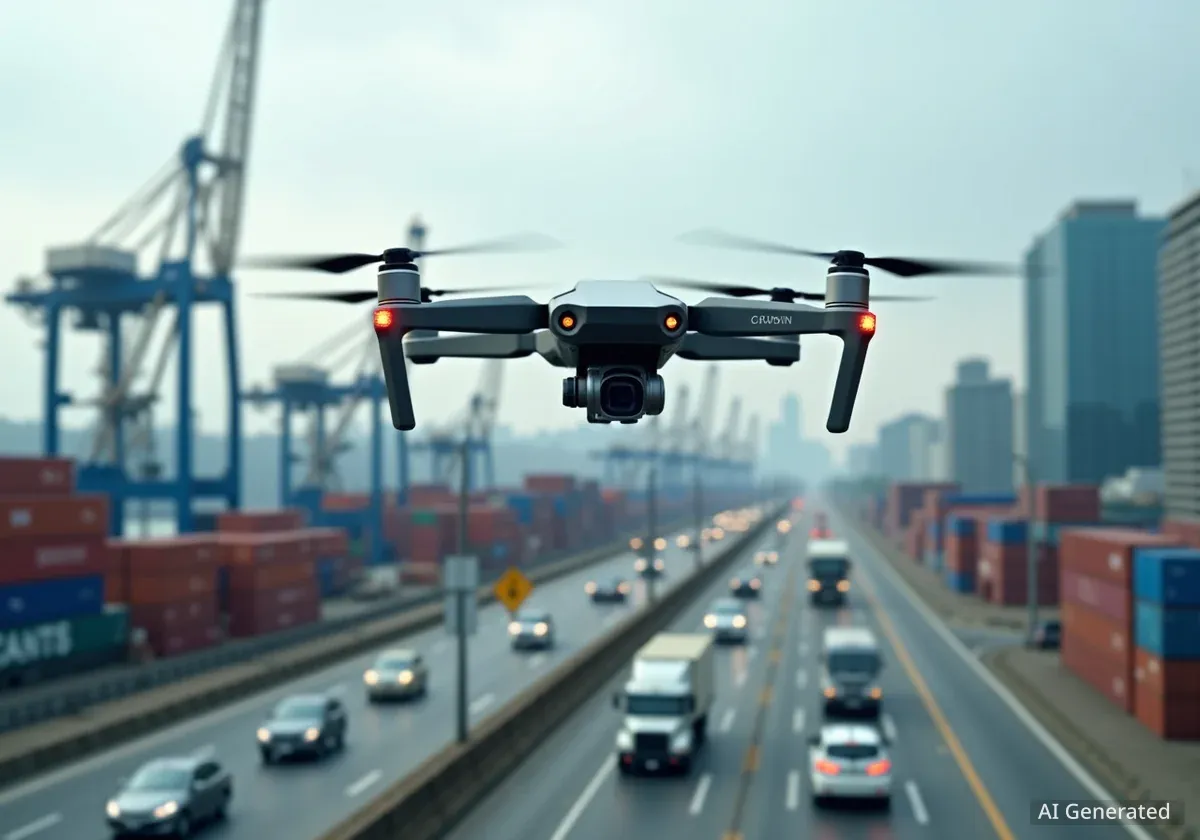Finland's capital, Helsinki, has implemented a new system using drones and artificial intelligence to address traffic congestion. The project focuses on the city's West Harbour, Europe's second busiest port, which handles approximately 6 million ferry passengers each year. The initiative aims to analyze and improve the flow of vehicles, public transport, cyclists, and pedestrians in this major transport hub.
The program, which began in 2023, uses aerial drones to capture video footage of traffic patterns. This visual data is then processed by an AI system to create simulations, allowing city planners to test new traffic management strategies virtually before implementing them in the real world. The project is part of a broader European Union initiative to develop smarter, more sustainable urban mobility solutions.
Key Takeaways
- Helsinki is using drones to collect traffic data at its busy West Harbour, a hub for 6 million annual ferry passengers.
- Artificial intelligence analyzes the drone footage to track cars, trams, bicycles, scooters, and pedestrians.
- The data is used to build a "digital twin," a virtual model of the port area for simulating traffic solutions.
- While the system is designed to be GDPR-compliant, experts have raised concerns about data privacy and cybersecurity.
- The initiative is part of the EU-funded ACUMEN project, with similar trials in Athens, Amsterdam, and Luxembourg.
A High-Tech Approach to a Congestion Problem
Helsinki's West Harbour is a critical junction connecting ferries with the city's tram, metro, and train networks. The high volume of passengers and vehicles often leads to significant congestion, particularly during peak times when cruise ships arrive and depart. To address this, the city's innovation company, Forum Virium Helsinki, has turned to advanced technology.
Since 2023, fleets of three to six drones have been deployed to record video of the area. These drones provide a comprehensive, bird's-eye view of how different modes of transport interact. The primary goal is to understand the route choices people make and identify bottlenecks in the system.
"The project is to improve traffic flow with AI solutions and create a basis for more sustainable urban mobility," stated Eero Jalo, a project manager at Forum Virium Helsinki.
By collecting detailed information, the city hopes to optimize connections between ferries and other forms of transport, making journeys smoother and more efficient for millions of travelers.
The ACUMEN Project
This initiative is part of a larger program called ACUMEN, which stands for AI-aided decision tool for seamless multimodal network and traffic management. Funded by the European Union's Horizon Europe program, it is led by Aalto University in Finland and involves partners from eight EU countries and Switzerland. The project aims to develop a toolkit and policy recommendations for cities across Europe, with final results expected in May 2026.
From Raw Footage to Actionable Data
The process of turning drone videos into useful information is handled by Mobilysis, a Swiss technology start-up. The company uses artificial intelligence to analyze the footage, detecting and classifying every object in motion, from cars and trams to electric scooters and pedestrians. The AI tracks their speed, direction, and interactions with one another.
This analysis provides granular insights into traffic behavior. According to Manos Barmpounakis, CEO of Mobilysis, the data reveals how ferry passengers continue their journeys after disembarking.
"These insights are crucial for designing better intermodal connections and making travel through the port area smoother and more sustainable," Barmpounakis explained.
The processed information is then used to build a "digital twin" of the harbour. This highly complex virtual model acts as an exact counterpart to the physical environment, allowing engineers and regulators to experiment with different traffic management strategies in a simulated space. This avoids the cost and disruption of real-world trials.
The digital twin technology allows planners to test various scenarios, such as changing traffic light timings, rerouting public transport, or adding new bike lanes, and accurately predict the impact on traffic flow before making any physical changes.
Addressing Privacy and Security Concerns
The use of drones for public surveillance naturally raises questions about privacy. Project organizers state that the system is designed to comply with Europe's General Data Protection Regulation (GDPR). According to Mobilysis, the drones are positioned at fixed points and record from a high-altitude, bird's-eye perspective. This viewpoint makes it impossible to identify individuals' faces or read vehicle license plates.
Furthermore, the company asserts that raw video files are never shared externally. Only the anonymized, AI-processed data showing movement trajectories is used for analysis.
However, some experts caution that compliance does not eliminate all potential risks. Alina Wernick of the University of Tübingen noted that citizens have no way of verifying how the data is being collected. She also pointed to potential cybersecurity vulnerabilities and the risk that different anonymized datasets could theoretically be combined to reveal personal information.
In response, the city of Helsinki has emphasized its commitment to transparency. "We are sharing this information on what happens in our test areas with drones," said Eero Jalo. "We keep this open and develop how to share this information for the citizens."
The Future of Urban Traffic Management
The Helsinki pilot is not just about observing traffic; it's about actively influencing it. The project will test "soft measures," such as providing route recommendations or offering incentives for traveling at off-peak times. The data gathered will also be used to develop a mobile application that can suggest alternative routes or modes of transport to users in real-time.
The broader goal is to support climate objectives by encouraging more sustainable travel choices. Similar trials are already underway in other major European cities, including Athens, Amsterdam, and Luxembourg, as part of the ACUMEN project.
While the technology offers a promising path toward more efficient and environmentally friendly cities, experts like Wernick argue that the public perception of such technologies is critical. The balance between collecting precise data for urban planning and protecting individual rights to privacy and security will remain a key challenge as smart city technologies become more widespread.





